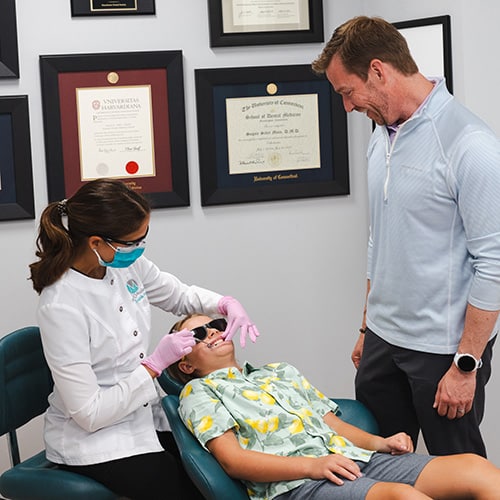When should a child have their first orthodontic checkup?
Timing is key in your child’s orthodontic journey, and age plays a crucial role. The American Association of Orthodontists (AAO) suggests that the ideal time for your child’s first orthodontic check-up is as soon as an orthodontic concern arises, but no later than age 7.
Why this age, you might wonder? Well, at around 7 years old, most children already have their adult first molars in place and some baby teeth have transitioned to permanent ones. Additionally, their jaw shape is well underway.
This transitional phase is when an orthodontist can spot potential issues. Dr. Sogole Moin can assess the developing teeth and jaws during this early evaluation, providing valuable insights. It’s also important to note that some dentists in our community are trained to detect orthodontic concerns early, and they might refer you to us even before your child turns 7 if they have any concerns.
Why start early Orthodontic evaluations for children?
Starting orthodontic treatment early can make a significant difference in addressing certain issues that might worsen over time if left untreated. While many orthodontic problems require treatment after all permanent teeth have come in, early intervention aims to intercept developing issues, address their root causes, guide the growth of facial and jaw bones, and create adequate space for incoming permanent teeth. Sometimes, a patient may require a second phase of treatment after all permanent teeth have erupted to optimize their positions.
Early orthodontic assessments and treatments offer several benefits. They enhance the alignment of teeth, ensure enough room for permanent teeth, and reduce the risk of injuries to front teeth. Dr. Moin can also influence the growth of the jaw and permanent teeth, make adjustments to dental arch widths, minimize the need for tooth extractions, prevent impacted teeth, and address habits such as thumb-sucking or speech concerns.
Is early treatment suitable for every child?
Not all children require early orthodontic treatment; in fact, most don’t. Some orthodontic issues are better addressed during the teenage years when all permanent teeth have come in. Additionally, specific skeletal orthodontic problems may necessitate waiting until growth is more advanced or complete before beginning treatment.
Dr. Moin develops customized treatment plans based on each child’s individual needs. If she determines that a child isn’t ready for treatment, she may place them in our orthodontic supervisory program. Nevertheless, it’s essential for every child to undergo an evaluation around age 7 to determine the most appropriate approach to their orthodontic care.
What is the Orthodontic Observation Program?
The Orthodontic Observation Program is designed for patients who are not yet ready for active orthodontic treatment, but require ongoing monitoring. It allows us to closely track the eruption of permanent teeth, addressing any irregularities early on. In some cases, correcting poor eruption patterns can be achieved by removing baby teeth ahead of time, potentially reducing the duration of future braces treatment. We also maintain communication with your general dentist, sharing any recommendations arising from our assessments during your visits.
Patients enrolled in this program typically return for recall appointments every 6-12 months, allowing us to observe their progress as they continue to grow. This program is provided at no additional cost and plays a crucial role in helping the orthodontist determine the optimal time to commence treatment, ultimately achieving the best possible outcome for your child.
If a child has treatment early, will this prevent the need for braces as an adolescent?
Starting orthodontic treatment in childhood can help reduce or even eliminate the need for braces in adolescence. It’s a proactive approach that aims to minimize future orthodontic issues, potentially avoiding extractions or surgeries. Early treatment effectively tackles significant problems, prevents them from getting worse, and simplifies future treatments. Since not all permanent teeth are in place during early treatment, their final alignment may not be perfect. Typically, a streamlined comprehensive phase of treatment, called Phase II takes place during the teen years to achieve the desired corrections once all permanent teeth have erupted. However, in some cases, additional orthodontic treatment may not be needed.







